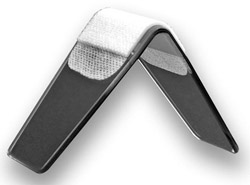Cutting-Edge Childbirth Technology Being Used at Memorial Medical
By Dr. Chitra Selvaraj
 |
Hem-Avert may save millions in health care costs. |
Memorial Medical Center is once again on the cutting edge of technology, this time in its commitment to women’s healthcare through the use of a newly approved medical device known as the Hem-Avert Perianal Stabilizer to help prevent painful external hemorrhoids during vaginal childbirth. Its widespread use could ultimately lead to significant reductions in health care costs for women by lowering the C-section childbirth rate, a much more expensive delivery procedure.
The Hem-Avert, invented by David Burton, a medical device industry veteran, is designed to provide counter-pressure to the anus during vaginal childbirth, the force of which helps prevent the occurrence of external hemorrhoids.
Burton is the CEO of Plexus Biomedical, Inc., of Oakland, TN., and he invented the noninvasive device after watching his wife suffer from the effects of external hemorrhoids during vaginal childbirth. The company received FDA approval to market the device in February of 2011 and Dr. David Burns, chief of obstetrics and gynecology at Memorial Medical Center, is one of the first physicians in the country to use the cutting-edge device.
Interviewed by the Niagara Falls Reporter, Dr. Burns said he has been using the device since it was approved by the FDA and “at first, the patient is concerned because they think it is invasive. Then they find out it is not invasive and cannot cause any harm to them or the baby and they love it.” In addition to preventing hemorrhoids, Dr. Burns said, “sometimes they have hemorrhoids already and afterward they are not sore at all. One woman that I delivered was so excited because she already had hemorrhoids and she had no problem at all.”
Dr. Burns said Memorial is the only hospital in New York that is purchasing the device for use by physicians.
“I can buy it as a physician and sell it to my patients in my office for their delivery,” he said. “But it’s very hard to get hospitals to pay for extras today. So it is a very good commitment to women’s health care being shown by Niagara Falls Memorial Hospital by buying this for physicians.”
While using the device at Memorial, Dr. Burns began to see a trend. Better patient outcomes. “I personally noticed a reduction in C-section rates at our hospital with the use of the device. The Hem-Avert helps women who have undergone an epidural, push more effectively. Our hospital is currently running a postdictive study looking at reduced C-section rates with use of the Hem-Avert device.”
As a result of Dr. Burns’ observations, the device’s manufacturer did a retrospective analysis of the study presented in the original FDA application and it indicated a 61 percent reduction rate in C-sections among patients who received the device compared to those who delivered without it.
Pat Bradley, public relations director at Memorial Medical, said when all the results are in, Dr. Burns and Burton “will be able to quantify and measure and extrapolate just how much money can be saved through the use of the device with the reduction of C-sections.”
Dr. Burns is running a random 200-patient, double-blinded study which he describes as slow, but exciting, and the first study he has conducted as the chief investigator. “I can tell you, the initial data is alarming,” he said. “Our section rate at Memorial, like many Level One Centers in New York State, is approaching 50 percent. And the control group we have seen so far after only 48 patients is at 54 percent, which goes along with the hospital section rate while our investigational group is at 18 percent. So we are seeing a reduction just after the first 48 patients and that is pretty exciting.”
Burton said he believes the study being conducted by Dr. Burns is timely and significant “now that C-sections are the largest surgical procedure for women and they represent one of the largest expenditure of health care dollars for women. It is less expensive to have a vaginal birth than a C-section.”
“For every one percent reduction in C-sections, you save approximately $100 million. “The World Health Organization came out about a year and a half ago and said there is no medical necessity for any country to have a C-section rate greater than 15 percent,” said Burton.
Burton, who developed the Hem-Avert Stabilizer, told the Reporter that the potential cost savings for payers and hospitals are enormous, and a study by Intermountain Healthcare suggests unnecessary C-sections are a billion dollar problem. The company is working on expanding its international distribution of the device.